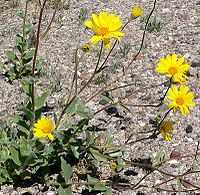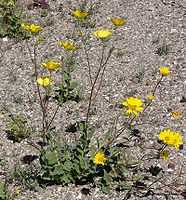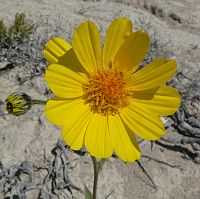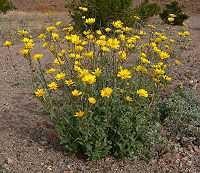Geraea canescens
| Geraea canescens | |
|---|---|
 | |
| Desert Sunflower (Geraea canescens) | |
| Scientific classification | |
| Kingdom: | Plantae |
| (unranked): | Angiosperms |
| (unranked): | Eudicots |
| (unranked): | Asterids |
| Order: | Asterales |
| Family: | Asteraceae |
| Genus: | Geraea |
| Species: | G. canescens |
| Binomial name | |
| Geraea canescens Torr. & Gray | |
Geraea canescens, commonly known as desert sunflower, hairy desert sunflower, or desert gold, is an annual plant in the family Asteraceae. "Geraea" in its scientific name comes from the Greek geraios ("old man"), referring to the white hairs on the fruits.[1]
G. canescens bears yellow sunflower-like flowers on slender, hairy stems. It grows 1–3 ft (0.30–0.91 m) high. The leaves are gray-green and grow to 3 in (8 cm) long. It flowers February through May after sufficient rainfall.
It is native to western North America, specifically Arizona, Nevada, California, and Utah. A drought-avoiding annual plant, it can be found in the California, Mojave, and Sonoran Deserts. It grows from −130 to 3,700 ft (−40 to 1,130 m) in sandy desert soil in the company of creosote bush (Larrea tridentata).[2]
The flowers attract bees and birds, and the seeds are eaten by birds and rodents.[3]
There are two varieties of Geraea canescens:
- Geraea canescens var. canescens
- Geraea canescens var. paniculata S.F.Blake
-

-

-

-

-
Closeup of fruits
References
External links
- USDA. Geraea canescens Torr. & Gray. Hairy Desertsunflower. PLANTS Profile.
- Geraea canescens. Lady Bird Johnson Wildflower Center.
- Picture of Desert Sunflowers in Death Valley
- CalPhotos page for desert sunflower
- Map of the Desert Sunflower's range
| Wikimedia Commons has media related to Geraea canescens. |
